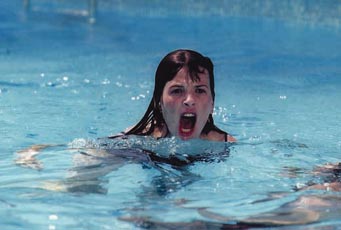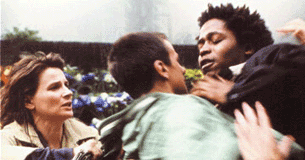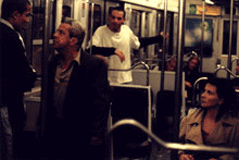
This film by Michael Haneke foregrounds the use of the 'long take'... what is a long take? Let's go back, back, back in time............

The beginning of cinema, it has been argued, can be precisely defined through The Lumière brothers. They had been the first to project images onto a screen. However, cinema is not simply framing a scene, shooting it, then projecting it. There is also montage. With this definition, and as Don Fairservice admirably points out, it was the Lumières’ L’Arrosseur arrossé that defines the beginning of cinema. L’Arrosseur arrossé is pivotal because its running time was just 39 seconds while a spool of film lasted 50 seconds and the Lumières had shot scenes using the entire spool up till then. The spool of L’Arrosseur arrossé was trimmed, trimmed to allow only the essential action: the man watering the garden, the child stepping on the hosepipe to stop the flow, the man looking into the hosepipe and the water knocking off his hat as the boy takes his foot away. The beginning of montage.
The potential and promise of montage created experimentation. Birt Acres filmed a horse race at Derby, he stopped the camera each time movement in the frame concluded, after the horses had left the frame. This was done, presumably, to both preserve film stock as well as eradicate ‘empty’ framing. However, stopping and restarting the camera created a flash of white light: an aberration. Acres thus edited these out: in this way the jump cut was created, which in itself became to be seen as an aberration. A solution was found in 1897. The procession of Queen Victoria’s jubilee was filmed from multiple setups along the route and the film joined together. This multiple setup created the illusion of continuity and the jump cut was avoided: aberration removed. Additionally this procedure actualised the potential of films to last over the 50 second spool length.
In Japan, the first filmmakers solved the problem of short spool length (the need to create longer sequences of action) and the jump cut in another way. Early Japanese films shot scenarios primarily from Kabuki theatre: positioning the camera some thirty feet from the action, reproducing the point of view of an audience. For this reason repositioning the camera was to be avoided. When the filmstock ran out the actors would hold positions (for what could be ten minutes) while a new spool was added and then the action continued. This solution, which involves editing together a number of shots to form a sequence, is similar to that of the Derby races in that the same problems were solved: avoidance of the jump cut, and extended sequences. However, the practicalities were different in that the former utilised a repositioning of the camera, while the latter did not. So it can be seen, even in the earliest of cinema schools with discrete methodologies were being formed through the divergent solutions to the same problems.
So, the 'long take' refuses to cut up action... refuses to compose a scene out of slices of film: close-up tp medium shot to long shot. Rather, the camera follows the action in real time... as Hanake says:
"The faster something is shown, the less able you are to perceive it as an object occupying a space in physical reality, and the more it becomes something seductive. And the less real the image seems to be... Of course, this type of aesthetic has gained the upper hand in commercial cinema... but one needs time to understand what one sees, which the current media disallows. Not just understand on an intellectual level, but emotionally.‘

Thus is the philospy of Code Unknown: one scene, one shot - the long take. A series of interconnected stories that emerge from a single event on a Parisian street... an angry white teenager abuses a woman from Eastern Europe who is begging, a young black man intervenes... the white youth is let off, the black youth arrested, the woman deported... from this point the lives of these characters and those around them are followed through several months...
The crucial point here is that Hanake uses the long take to give the viewer the oppostunity feel the 'action' in real time... an actress irons her clothes while watching the tele... she hears screams... she turns down the volume of the tele... a young child is being abused (she believes) upstairs... she is sad... all too soon something catches her eye on the tele and the volume goes up again... all of this is rendered in real time... and the spectator feels just how easy it is not to intervene... Or... on the tube train, when the self identified arab youth abuses the middleclass, white, female actress and spits in her face... the other passengers just sit there... rendered in real time this scene is almost unbearable... and you think about what you would do...

One man eventually intervenes... what would you do? This film then, consists of a series of interventions and non-interventions... all rendered in real time through the long take...
Labels: Code Unknown, David Deamer, editing, Michael Haneke, montage, The Long Take



0 Comments:
Post a Comment
<< Home